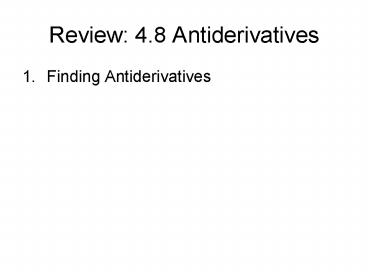Review: 4'8 Antiderivatives - PowerPoint PPT Presentation
1 / 24
Title:
Review: 4'8 Antiderivatives
Description:
To solve an initial value problem. Find the general solutions for antiderivatives ... Algebra Rules. 3) Algebra Rules. Sum rule. Difference Rule. Constant ... – PowerPoint PPT presentation
Number of Views:36
Avg rating:3.0/5.0
Title: Review: 4'8 Antiderivatives
1
Review 4.8 Antiderivatives
- Finding Antiderivatives
2
Antiderivative Formulas
- 2. Antiderivative Formulas
- f(x)xn,
- F(x) xn1C
- f(x)sin(kx)
- F(x)- cos(kx)C
- f(x)cos(kx)
- F(x) sin(kx)C
- f(x)sec2x
- F(x)tanxC
3
Antiderivative Formulas
- 5) f(x)csc2x
- F(x)-cot xC
- f(x)sec x tan x
- F(x)sec x C
- f(x)csc x cotx
- F(x) -csc x C
4
Antidifferentiation Rules
- 3. Antiderivative Linearity Rules
- function general antiderivative
- 1) kf(x), kF(x)C
- 2) f(x)g(x) F(x)G(x)C
- 3) f(x)-g(x) F(x)-G(x)C
5
Initial Value Problems and Differential Equations
- 4. Differential Equatons
- To solve an initial value problem
- Find the general solutions for antiderivatives
- Use the initial value condition to determine the
constant C.
6
Indefinite Integrals
- 5. Indefinite Integrals
- 1) Defintion
- The collection of all antiderivatives of f is
called the indefinite integral of f, and is
denoted by - The function f is called the integrand of the
integral. - It is a special symbol to represent the general
antiderivative.
7
Examples
- 2) Examples
- a)
- b)
- c)
8
Discussion of Homework Problems
- page 314-316.
9
Chapter 5 Integration
- Estimating with finite sums
- Sigma notation and limits of finite sums
- The definite integral
- The fundamental Theorem of Calculus
- Indefinite integral and substitution rule
- Substitution and area between two curves
10
5.1 Estimating with Finite Sums
- Area
- Ex. Estimate the area of the region R under the
graph of f(x)x21 from x0 to x2. - Solution Let A be the area of the region R. We
use two different rectangles - inscribed rectangles and circumscribed
rectangles. - Divide the interval 0,2 into two equal parts.
11
- Now we have two intervals0,1 and 1,2.
- First, we use the circumscribed rectangles.
- The total area of the circumscribed rectangles
is - 1(2)1(5)7 --an upper sum
- The sum of areas of circumscribed rectangles is
called an upper sum. - The total area of the inscribed rectangles is
- (1)(1)(1)(2)3 -- a lower sum
- The sum of areas of circumscribed rectangles is
called a lower sum.
12
- So 3ltAlt7.
- Now let us divide the interval 0,2 into four
equal parts. 0, ½, 1/2, 1, 1, 3/2, 3/2,2 - So the upper sum
- 1/2(5/4)1/2(2)1/2(13/4)1/2(5)
- 5/8113/85/2
- 23/4
- the lower sum
- 1/2(1)1/2(5/4)1/2(2)1/2(13/4)
- 1/25/8113/8
- 15/4
- So 15/4ltAlt23/4.
13
Summary
- By taking more and more rectangles, with each
rectangle thinner than before, the finite sums
give a better and better approximation to the
true area of the region R.
14
Practice
- 2 on page 333.
15
5.2 Sigma Notation and Limits of Finite Sums
- Finite Sums and Sigma Notation
- Sigma Notation
- The sum of n terms is written as
- The Greek letter stands for sum. The index
of summation k tells where the sum begins and
where the sum ends
16
Examples
- 2) Examples
- (a)
- (b)
17
Algebra Rules
- 3) Algebra Rules
- Sum rule
- Difference Rule
- Constant Multiple Rule
- Constant Value Rule
18
Some Formulas
- a)
- b)
- c)
19
Examples
- a)
- b)
20
Limits of Finite Sum
- 2. Limits of Finite Sum
- By taking more and more rectangles, with each
rectangle thinner than before, the finite sums
(both lower sum and upper sum) give a better and
better approximation to the true area of the
region R. So the limit of the finite sum is the
true area.
21
Riemann Sums
- 4. Riemann Sums
- We begin with any function f defined on
- a, b. Now divide the interval a, b into n
subintervals. - a, x1, x1, x2, x2, x3, ., xn-1, b
- The set Pa, x1, x2,.., b
- x0, x1, x2,.., xn
- is called a partition of a, b
22
- In each subinterval xk-1, xk we select a point
ck. Then the area of the small rectangle over
xk-1, xk with height f(ck) is - f(ck)(xk- xk-1) f(ck) ? xk
- We sum all these areas to get
- This sum is called a Riemann sum for f on the
interval a, b. The largest width of all
subintervals is called the norm of the partition
P and is denoted by P.
23
Practice
- 2, 8, 12, 18, 20 on page 342-343.
24
Homework
- 1,3, 5 on page 333
- 1-11 odd, 15, 17, 19, 23 on page 342-343.































